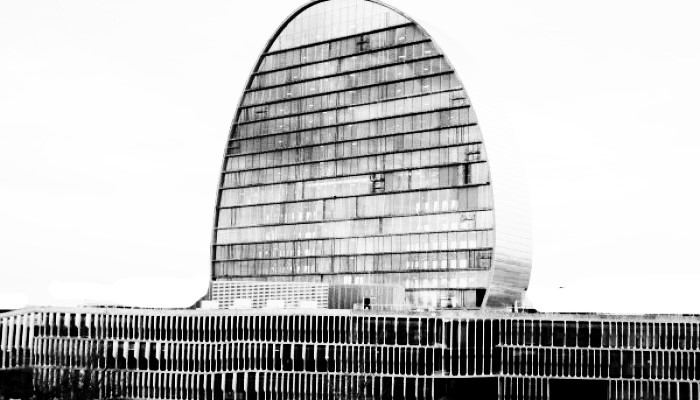Una teoría de la evolución arquitectónica. Cambiar para perdurar.
Herzog tiene la clave: cambiar para perdurar. Sostiene que la durabilidad de un edificio no depende de la solidez de su construcción, sino de su versatilidad, de su facilidad para cambiar de uso y, por tanto, de admitir sucesivas rehabilitaciones. Jacques Herzog, junto a su socio Pierre de Moureon, ambos premio Pritzker de arquitectura 2001, inauguran en el Norte de Madrid la nueva sede del BBVA y aplica esa premisa en el proyecto con indiscutible maestría.
Pero no fue tan sencillo. A su llegada a Madrid, lo que encontraron los arquitectos suizos fue una zona muy nueva, algo desangelada y árida; sin vida fuera y sin identidad propia. Un desierto, empleando su terminología. Así que ambos idearon un proyecto para que, cuando la ciudad llegue hasta allí, el edificio acabe siendo absorbido y cambie sus usos. Jacques Herzog sostiene que se puede introducir el poder con monumentalidad para “asustar” a la gente, aunque a ellos les interesa más introducir en los grandes espacios la escala íntima. Así lo hicieron, sin ir más lejos, en el proyecto que les lanzó a la fama mundial, la importantísima rehabilitación con cambio de uso de la Tate Modern de Londres. Allí, cuentan, descubrieron la ciudad y aprendieron a trabajar con poca arquitectura y a dar más importancia al pensar que a dibujar.

Esta insigne pareja de arquitectos suizos insiste en que, en un futuro lejano, su proyecto se transformará en un barrio en el que las viviendas y las tiendas sustituirán a las oficinas. Ha sucedido ya con palacios, parques y monasterios que acaban formando parte integrante e integradora del paisaje urbano, tras una oportuna rehabilitación. Y eso sucederá en esta sede bancaria también. Esa es, sin duda, la pretensión de Herzog, firme partidario de la reconversión de los inmuebles para usos adscritos al devenir de los tiempos. Es una especie de teoría de la evolución, aplicada, con enorme acierto y modernidad, al concepto de arquitectura.
Se declara partidario de la trama medieval y de la intensa vida callejera que la acompaña, y afirma que este pulso vital hacia el exterior de la casa propia, hacia el espacio público, está en retroceso en toda Europa. Con una salvedad interesante: España, un país en el que también se vive de puertas para afuera. Las urbanizaciones en el centro ponen en solfa la pervivencia de la vida en la calle típica de la ciudad mediterránea, la que se entrelazan en un mismo recorrido comercios, viviendas, espacios de ocio y vida cívica. La arquitectura, por tanto, no debe enviar un mensaje único, cerrado, inamovible.
Estos artífices de arquitectura suiza consideran que la belleza no se inventa, sino que se produce cuando los edificios funcionan. La nueva sede del BBVA también lo hará.